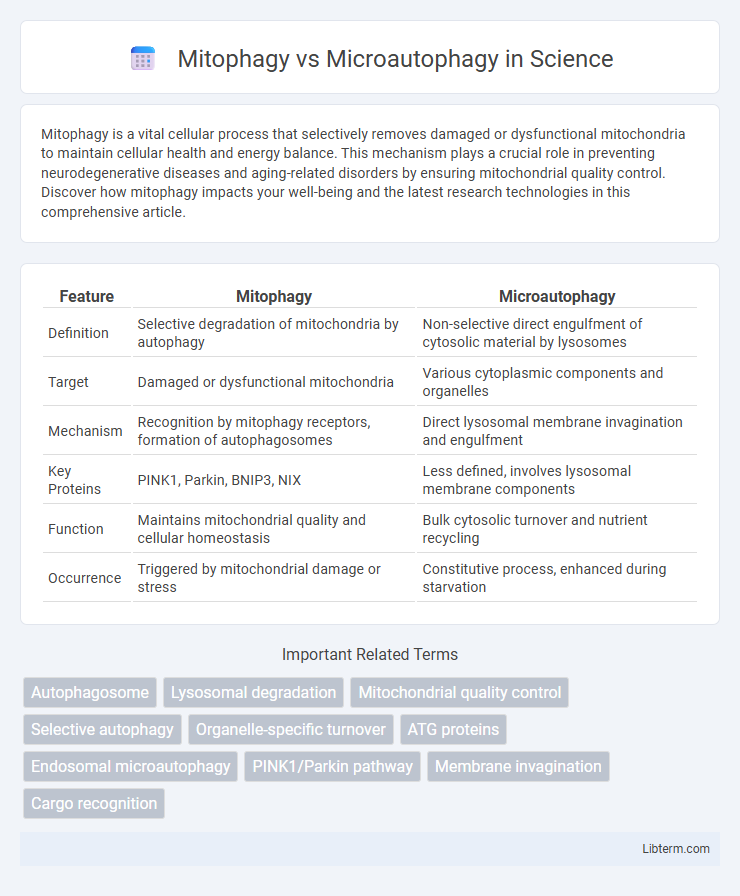Mitophagy is a vital cellular process that selectively removes damaged or dysfunctional mitochondria to maintain cellular health and energy balance. This mechanism plays a crucial role in preventing neurodegenerative diseases and aging-related disorders by ensuring mitochondrial quality control. Discover how mitophagy impacts your well-being and the latest research technologies in this comprehensive article.
Table of Comparison
| Feature | Mitophagy | Microautophagy |
|---|---|---|
| Definition | Selective degradation of mitochondria by autophagy | Non-selective direct engulfment of cytosolic material by lysosomes |
| Target | Damaged or dysfunctional mitochondria | Various cytoplasmic components and organelles |
| Mechanism | Recognition by mitophagy receptors, formation of autophagosomes | Direct lysosomal membrane invagination and engulfment |
| Key Proteins | PINK1, Parkin, BNIP3, NIX | Less defined, involves lysosomal membrane components |
| Function | Maintains mitochondrial quality and cellular homeostasis | Bulk cytosolic turnover and nutrient recycling |
| Occurrence | Triggered by mitochondrial damage or stress | Constitutive process, enhanced during starvation |
Introduction to Cellular Autophagy
Mitophagy and microautophagy are two crucial types of cellular autophagy involved in maintaining cellular homeostasis. Mitophagy selectively targets damaged or superfluous mitochondria for degradation, ensuring mitochondrial quality control, while microautophagy involves the direct engulfment of cytoplasmic components by lysosomes through membrane invagination. Understanding these processes highlights their distinct mechanisms in cellular waste management and energy regulation.
Understanding Mitophagy: Definition and Mechanisms
Mitophagy is a selective form of autophagy that targets damaged or superfluous mitochondria for degradation via lysosomes, ensuring cellular homeostasis and mitochondrial quality control. This process involves key proteins such as PINK1 and Parkin that recognize dysfunctional mitochondria, promoting their engulfment by autophagosomes before lysosomal degradation. Unlike microautophagy, which non-selectively engulfs cytoplasmic material through direct lysosomal membrane invagination, mitophagy is a highly regulated mechanism critical for preventing mitochondrial dysfunction and related diseases.
Microautophagy: Definition and Cellular Role
Microautophagy is a lysosome-mediated degradation process where the lysosomal membrane directly engulfs cytoplasmic components through invagination, enabling the recycling of cellular constituents. This mechanism plays a crucial role in maintaining cellular homeostasis by selectively degrading damaged organelles and protein aggregates. Unlike mitophagy, which specifically targets mitochondria for autophagic clearance, microautophagy acts as a more generalized pathway for the turnover of diverse cytosolic materials.
Key Molecular Players in Mitophagy
Mitophagy involves key molecular players such as PINK1, which accumulates on damaged mitochondria, and Parkin, an E3 ubiquitin ligase that tags these mitochondria for degradation. Other important components include the autophagy receptors NDP52 and OPTN, which recognize ubiquitinated mitochondria and recruit the autophagy machinery. In contrast, microautophagy operates through direct engulfment of cytoplasmic material by the lysosomal membrane, relying less on specific molecular markers like those seen in mitophagy.
Molecular Pathways Involved in Microautophagy
Microautophagy involves the direct engulfment of cytoplasmic material by lysosomes through membrane invagination, mediated by components such as the Endosomal Sorting Complex Required for Transport (ESCRT) machinery and Atg proteins that regulate membrane dynamics. Key molecular pathways include the activation of TORC1 signaling, which modulates autophagy initiation, and the involvement of the vacuolar membrane proteins that facilitate substrate sequestration and lysosomal degradation. Unlike mitophagy, which specifically targets damaged mitochondria via PINK1/Parkin-dependent ubiquitination and receptor-mediated pathways, microautophagy lacks strict cargo specificity and relies on membrane remodeling proteins and lipids to internalize bulk cytoplasmic components.
Biological Significance: Mitophagy vs Microautophagy
Mitophagy selectively degrades damaged or dysfunctional mitochondria, maintaining cellular energy homeostasis and preventing oxidative stress-related diseases. Microautophagy non-selectively engulfs and recycles cytoplasmic components via lysosomal membrane invagination, supporting general cellular quality control and nutrient recycling. Both processes are critical for cellular health but differ in specificity and their roles in metabolic regulation and stress response.
Differences in Mechanism: Mitophagy vs Microautophagy
Mitophagy is a selective autophagy process that specifically targets damaged or superfluous mitochondria for degradation through the formation of autophagosomes, which then fuse with lysosomes. Microautophagy involves the direct engulfment of cytoplasmic components, including organelles, by lysosomal membrane invagination without autophagosome formation. The key mechanistic difference lies in mitophagy's receptor-mediated recognition and isolation of mitochondria, whereas microautophagy relies on lysosomal membrane dynamics to sequester substrates non-selectively or selectively.
Physiological and Pathological Implications
Mitophagy selectively degrades damaged or superfluous mitochondria to maintain cellular energy homeostasis and prevent oxidative stress-related diseases, playing a critical role in neurodegenerative disorders like Parkinson's disease. Microautophagy involves the direct engulfment of cytoplasmic components by lysosomes, contributing to general cellular quality control and adaptation to nutrient deprivation. Dysregulation of mitophagy leads to mitochondrial dysfunction and apoptosis, while impaired microautophagy affects lysosomal degradation efficiency, influencing aging and metabolic pathologies.
Research Techniques for Studying Mitophagy and Microautophagy
Advanced research techniques for studying mitophagy include fluorescence microscopy using mitochondrial-targeted probes like mito-Keima, which enables real-time visualization of mitochondrial degradation. In microautophagy studies, electron microscopy remains a gold standard for observing direct lysosomal engulfment of cytoplasmic components, complemented by immunogold labeling to identify specific proteins involved. Quantitative assays such as Western blotting for autophagy-related proteins (e.g., LC3, PINK1, Parkin) and flow cytometry provide critical data on the dynamics and regulation of both mitophagy and microautophagy pathways.
Future Perspectives and Therapeutic Potential
Mitophagy selectively targets damaged mitochondria for degradation, playing a crucial role in maintaining cellular health and preventing neurodegenerative diseases, while microautophagy non-selectively engulfs cytoplasmic components through lysosomal membrane invagination, contributing to cellular homeostasis. Emerging therapies focus on enhancing mitophagy pathways, such as PINK1/Parkin modulation, to treat conditions like Parkinson's disease and mitochondrial myopathies, whereas microautophagy manipulation holds promise in cancer and aging by regulating lysosomal function and autophagic flux. Future research aims to develop targeted drugs that precisely modulate these autophagic mechanisms, improving efficacy and minimizing off-target effects.
Mitophagy Infographic

 libterm.com
libterm.com